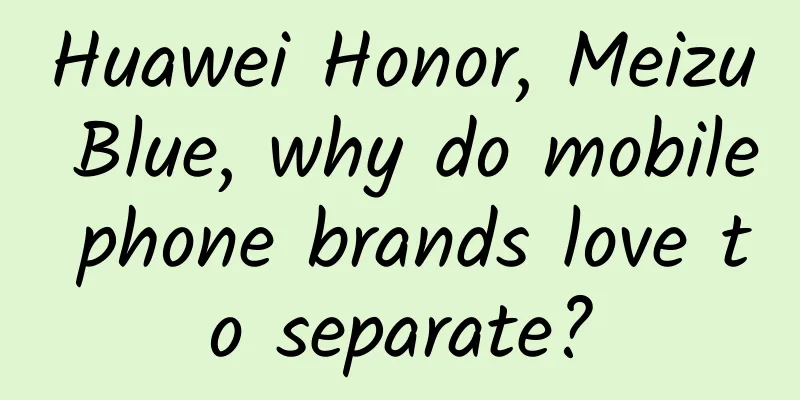Huawei Honor, Meizu Blue, why do mobile phone brands love to separate?

|
Recently, iPhone 8/8 Plus, iPhone X, Huawei Mate 10, OPPO R11, Xiaomi MIX 2, vivo X20 and many other mobile phones have been released one after another, which makes people sigh at the fierce competition in the mobile phone industry. The fierce market competition is also the succession process of mobile phone brands. In recent years, brands such as Nokia and Motorola have gradually declined, while Apple, Huawei and Xiaomi have become famous. The ups and downs of mobile phone brands give people a warning: there is no permanent first in the Internet era. The smartphone industry is changing so fast that many industry insiders can't keep up. However, it is particularly important for companies to follow the clues and adapt to market changes and make adjustments to business strategies at any time. In May 2017, Meizu Technology adjusted the company's organizational structure and divided the company into three major business units: Meizu Business Unit, Meizu Blue Business Unit, and Flyme Business Unit, confirming the rumors of the separation of Meizu and Meizu Blue. In fact, there are many representatives of mobile phone brands that operate independently from their parent brands, such as Huawei and Honor, Coolpad and Dasheng... The market is fierce, and domestic mobile phone brands prefer to "separate" According to data released by German research institution Gfk on the 24th, China's smartphone retail sales have reached 117 million units. It is expected that China's smartphone retail sales will reach 464 million units in 2017, a year-on-year increase of 4%, and the market size is expected to increase by 16% year-on-year (in US dollars). In addition, data from market research institution Strategy Analytics shows that in the second quarter of 2017, among the top five mobile phone manufacturers in the world in terms of mobile phone shipments, three are domestically produced, namely Huawei, OPPO and Xiaomi. The above two surveys show that domestic smartphone sales are on the rise, and domestic brands have become famous in the international market. Chinese mobile phone brands are in a stage of rapid growth. Therefore, in order to seize a higher market share, mobile phone brands such as Huawei and Meizu have separated new mobile phone brands from their parent brands, intending to get more trump cards and occupy more market share through separation. Honor is an Internet mobile phone brand launched by Huawei. After being separated, it launched a series of products such as Honor 3C and Honor 3X, becoming a "rising star" in the mobile phone market. According to Canalys data, Honor's sales from January to August 2017 reached 35.131 million units, becoming the sales champion of Internet mobile phones in the Chinese market. Many people did not have high hopes for this Huawei sub-brand at the beginning, but now it has created its own space and has become a presence in the smartphone market that cannot be underestimated. After Huawei's independent Honor, Meizu recently also sold Meizu and Meizu Blue independently. According to Meizu's official website, Meizu Blue has its own independent official website and will use a new domain name. Regarding this adjustment, Li Nan, vice president of Meizu Technology, said: Meizu Blue is positioned as a youth quality product. The brand has always been operated independently, but the outside world has always regarded Meizu Blue as a sub-brand of Meizu. When Meizu Blue mobile phones are completely independent, Meizu Blue will be more focused on products and better interpret the definition of youth quality products. To sum up, in the fiercely competitive market, after mobile phone brands became independent from the parent brands, some have carved out a niche for themselves, some have disappeared, and some are still struggling... But no matter what the outcome is after independence, we all have a question, why do mobile phone brands love to split up? Brand awareness is one of the factors that consumers consider when buying mobile phones, and brand influence has always been a factor that affects the smartphone market. After a series of mobile phone brands have independently operated, people can't help but wonder: Huawei, Meizu, etc. are already well-known big brands, so why do they need to independently create a new mobile phone brand? Meilan: Solving the problem of brand aging In the past two years, the domestic smartphone market has been in constant competition. Under the impact of new brands, old brands such as Meizu and Coolpad, which have been struggling to survive, have experienced brand aging. The so-called brand aging refers to the decline of brand awareness and reputation, shrinking sales, and reduced market share in the market competition. Last year, Meizu invited celebrities to perform at 12 of its 14 press conferences. Although it successfully occupied the headlines, the sales were not satisfactory. Survey data showed that Meizu sold only 22 million mobile phones in 2016, failing to achieve the annual target of 25 million units. This year, Meizu and Meilan established business units respectively, which shows that Meizu has also realized the aging status of the brand and started to solve it. As we all know, it is very difficult for a big brand like Meizu to subvert the original market impression and achieve breakthrough innovation. Therefore, the problem of brand aging is imminent. Not changing at this time is tantamount to waiting for death. Therefore, it becomes the best choice to independently create a new brand and realize its independent operation. On the one hand, Meizu's Meilan is the brand with the greatest consumer potential. Meizu's many years of supply chain resources and design experience can be given to Meilan, so that it has better design and quality, so as to win the market and reputation in the thousand-yuan price range that young people can accept. On the other hand, if Meizu wants to compete with OPPO and vivo, it is much more difficult to change itself alone, but it is much easier to rely on Meilan to start a new business and reshape the new Meilan brand. In this way, Meizu still relies on Meizu for resources, and the profits of Meizu can also return to Meizu and feed back to the parent company. Of course, for Meizu to gain a foothold in the fierce market, it must have long-term technical accumulation and sufficient brand premium ability. It is better for both brands to break through separately than to blindly immerse them in the chaotic market for a long time, and perhaps they can open up a new space in the fiercely competitive market. In general, the independence of Meizu Blue has broken the shackles of old brands. But at the same time, Meizu Blue also needs a clear long-term strategy to strive to improve its comprehensive strength in products, technology, services, marketing, etc., make its products more competitive, and thus completely get rid of the shackles of the parent brand. Honor: Filling the gap in Huawei's Internet mobile phone brand The domestic mobile phone market has undergone tremendous changes in the past few years. The reason is that new Internet brands such as Meizu and Xiaomi, which have local advantages, have risen rapidly and disrupted the original mobile phone market structure. With the advent of more and more Internet brand mobile phones, the competition in the mobile phone market is becoming increasingly fierce. The establishment of an Internet mobile phone fan ecosystem has also become the key to competing for market share. In an era when AI phones are still priced at over 3,000 yuan, the price of Internet mobile phone brands is only 1,000 yuan or even lower. Its high cost-performance ratio has attracted many working-class consumers. For Huawei, the core competitiveness of other Internet mobile phones is not terrible, but the fact that there are a large number of loyal fans behind them. Therefore, if Huawei wants to successfully establish a mobile phone brand, it must pay attention to the operation of fans, and Honor's independent operation is an important way to attract fans and build a fan ecosystem. In the early stage, the Huawei mobile phone fan forum was relatively quiet, and most of the content was about user feedback on product optimization, and the fan interaction was not satisfactory. In addition, Huawei mobile phones are mainly sold offline, while Honor's sales are only through e-commerce channels. After independent operation, the online and offline after-sales service system has become more and more mature, and consumers can enjoy more and more services. In addition, Huawei lacked Internet thinking in its early days, and had no concept of fans. Now, most people who are exposed to the Internet are young people, and the mobile phone consumer group has also changed from those born in the 1980s to those born in the 1990s who are familiar with the Internet. In order to attract a new generation of consumers, Honor follows the ideas of young people in the design, pricing, sales and sales of mobile phones; it has made great improvements in quality control and pursuit of innovation. In short, brand value-added, content monetization and product premium are all ways out that mobile phone manufacturers are exploring. No matter which path they choose, they cannot do without the support of users. Mobile phone brand "separation" brings joy but also worries After the Internet mobile phone became popular, mobile phone manufacturers such as Coolpad and Huawei launched new brands. Some of them became more and more popular after the separation, while some mobile phone brands gradually became lonely after the separation. It can be seen that the separation of mobile phone brands has both joy and worries. First, brand reputations influence each other. If a new brand does not develop well, it will affect the reputation of the parent brand. If the parent brand fails to improve its reputation, it will be difficult for the new brand to make a name for itself. Take Dasheng mobile phones, for example. After Coolpad was acquired by LeTV, it gradually disappeared from people's sight. Secondly, for traditional mobile phone manufacturers, operating a sub-brand independently is a new challenge. The independence of a mobile phone brand means abandoning the old brand and operating it anew. Reshaping the brand image requires a lot of resources, time and energy, and it is not easy for consumers to re-recognize the two brands. In addition, facing the current "melee" industry structure of the domestic mobile phone market, new brands must make breakthroughs in products, marketing, channels, supply chains, etc. in the short term to avoid being easily eliminated. Third, the original resources of mobile phone manufacturers are divided into two, and their value may be weakened. Independent brands require independent teams and thinking to operate, which will cause the diversion of original resources. The rapid growth of new brands will consume a lot of resources, thereby dragging down the overall operation progress, slowing down technology updates, and reducing innovation. In the case of limited resources, independent sub-brands may cause resource dispersion. In this regard, separating an independent brand is indeed not conducive to overall development. In general, in the fierce smartphone market, traditional mobile phone brands will be eliminated if they do not change. If mobile phone brands want to increase sales, they need to adjust their business strategies. Establishing new mobile phone brands, forming a mobile phone brand ecosystem, getting closer to fans, and achieving the effect of increasing sales and enhancing brand effect are just one of their options to conquer the mobile phone market. As a winner of Toutiao's Qingyun Plan and Baijiahao's Bai+ Plan, the 2019 Baidu Digital Author of the Year, the Baijiahao's Most Popular Author in the Technology Field, the 2019 Sogou Technology and Culture Author, and the 2021 Baijiahao Quarterly Influential Creator, he has won many awards, including the 2013 Sohu Best Industry Media Person, the 2015 China New Media Entrepreneurship Competition Beijing Third Place, the 2015 Guangmang Experience Award, the 2015 China New Media Entrepreneurship Competition Finals Third Place, and the 2018 Baidu Dynamic Annual Powerful Celebrity. |
<<: Another Tesla accident: Model X collided with Porsche and other vehicles in Chengdu
Recommend
These Chinese scientists have built a photonic city on a chip the size of a little fingernail!
Produced by: Science Popularization China Author:...
When will the plum rain season begin in Hangzhou, Zhejiang in 2022? When exactly does the plum blossom season end? Attached is the latest rainy season time
Recently, not only has the rainfall in southern m...
It is hard to imagine what kind of mental state these mechanical animals were made in...
Do you still remember the mythical animal "t...
A year-round activity planning plan for a million-level traffic APP
I have produced four complete monthly activity pl...
Terrifying-looking "doomsday fish" have come ashore one after another. Is the great disaster coming? Don't be silly...
One day in early November, in Encinitas, Californ...
Android Data Adapter Optimization: Efficient ViewHolder
When using Listview or GridView, a custom data ad...
Siping Mini Program Development Company, how much does it cost to make a moving mini program?
How much does it cost to be an agent for a moving...
He Xiaopeng's view on the new energy vehicle market: Xiaopeng will occupy one of the seven parts of the market? Not necessarily!
At the "10 Years of Passion Night" pres...
It only takes 3 steps to reduce the cost of information flow advertising. Which step have you taken?
Dear optimizer friends, have you ever encountered...
Outsourcing order-taking platform, where can SEOs take outsourcing work?
SEO is a profession and also a job. The purpose o...
You really need to know how often you should change your towels!
Have you ever encountered a towel that sheds, fad...
App opening screen ads have a new "shake" trick: suspected of infringing on consumers' right to choose independently
Have you ever found that when you open some apps,...
He Xiaopeng drove the world's first AI car to the Yunqi Conference, deepening the cooperation with Alibaba Cloud on AI computing power
On September 19, He Xiaopeng, Chairman and CEO of...
Google's chief futurist: Humans will begin to achieve immortality in 2029
On April 22, according to the American technology...
The so-called "Seven Planets in a Conjunction" is a rehash of astronomy, but how many of them can we actually see?
For the general public, the so-called "Seven...









